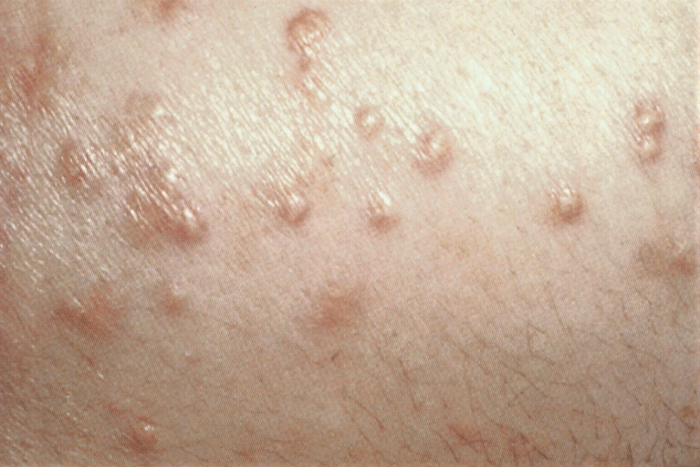Summary
Definition
History and exam
Key diagnostic factors
- presença de fatores de risco
- xantomas eruptivos
- lipemia retiniana
Other diagnostic factors
- IMC/circunferência da cintura elevada
- lipodistrofia
- características da doença arterial coronariana
- claudicação
- características neurológicas
- dor abdominal recorrente
Risk factors
- história familiar de hiperlipidemia
- dieta rica em gordura saturada
- dieta rica em carboidratos ou alto índice glicêmico
- consumo excessivo de álcool
- história familiar ou pessoal de sobrepeso/obesidade
- história familiar ou pessoal de diabetes
- resistência insulínica
- doença hepática
- doença renal
- Infecção pelo vírus da imunodeficiência humana (HIV)
- uso de determinados medicamentos
- Síndrome de Cushing
- distúrbios inflamatórios/imunológicos
- transplante de órgãos
- hipotireoidismo
- gestação
Diagnostic tests
1st tests to order
- nível de triglicerídeos
Tests to consider
- apolipoproteína B
- glicemia de jejum
- ureia, creatinina
- albumina/proteína urinária
- albumina sérica
- hormônio estimulante da tireoide
- testes da função hepática
- proteína C-reativa
Treatment algorithm
quilomicronemia
HTG moderada (triglicerídeos em jejum ≥1.7 mmol/L [≥150 mg/dL] ou triglicerídeos sem jejum ≥2.0 mmol/L [≥175 mg/dL] e triglicerídeos <5.6 mmol/L [<500 mg/dL])
HTG grave (triglicerídeos em jejum ≥5.6 mmol/L [≥500 mg/dL] especialmente triglicerídeos em jejum ≥11.3 mmol/L [≥1000 mg/dL])
Contributors
Authors
Robert A. Hegele, MD, FRCPC, Cert Endo, FACP, FAHA
Jacob J. Wolfe Distinguished Medical Research Chair
Martha Blackburn Chair in Cardiovascular Research
Distinguished University Professor of Medicine and Biochemistry
University of Western Ontario
London
Ontario
Canada
Disclosures
RAH reports consulting fees from Acasti, Aegerion, Akcea/Ionis, Amgen, Boston Heart, HLS Therapeutics, Novartis, Pfizer, Regeneron, Sanofi and UltraGenyx. RAH is an author of references cited in this topic.
Acknowledgements
Dr Robert A. Hegele would like to gratefully acknowledge Dr David Alexander Leaf, the previous contributor to this topic.
Disclosures
DAL declares that he has no competing interests.
Peer reviewers
Vinaya Simha, MBBS, MD
Associate Professor
Mayo Clinic
Rochester
MN
Disclosures
VS declares that he has no competing interests.
Peer reviewer acknowledgements
BMJ Best Practice topics are updated on a rolling basis in line with developments in evidence and guidance. The peer reviewers listed here have reviewed the content at least once during the history of the topic.
Disclosures
Peer reviewer affiliations and disclosures pertain to the time of the review.
References
Key articles
Grundy SM, Stone NJ, Bailey AL, et al. 2018 AHA/ACC/AACVPR/AAPA/ABC/ACPM/ADA/AGS/APhA/ASPC/NLA/PCNA guideline on the management of blood cholesterol: a report of the American College of Cardiology/American Heart Association task force on clinical practice guidelines. Circulation. 2019 Jun 18;139(25):e1082-143.Full text Abstract
Laufs U, Parhofer KG, Ginsberg HN, et al. Clinical review on triglycerides. Eur Heart J. 2020 Jan 1;41(1):99-109c.Full text Abstract
Berglund L, Brunzell JD, Goldberg AC, et al; Endocrine Society. Evaluation and treatment of hypertriglyceridemia: an Endocrine Society clinical practice guideline. J Clin Endocrinol Metab. 2012 Sep;97(9):2969-89.Full text Abstract
Virani SS, Morris PB, Agarwala A, et al. 2021 ACC expert consensus decision pathway on the management of ASCVD risk reduction in patients with persistent hypertriglyceridemia: a report of the American College of Cardiology Solution Set Oversight Committee. J Am Coll Cardiol. 2021 Aug 31;78(9):960-93.Full text Abstract
Mach F, Baigent C, Catapano AL, et al. 2019 ESC/EAS guidelines for the management of dyslipidaemias: lipid modification to reduce cardiovascular risk. Eur Heart J. 2020 Jan 1;41(1):111-88.Full text Abstract
Jellinger PS, Handelsman Y, Rosenblit PD, et al. American Association of Clinical Endocrinologists and American College of Endocrinology guidelines for management of dyslipidemia and prevention of cardiovascular disease. Endocr Pract. 2017 Apr;23(Suppl 2):1-87.Full text Abstract
Reference articles
A full list of sources referenced in this topic is available to users with access to all of BMJ Best Practice.

Differentials
- Diabetes
- Lipodistrofias
- Doença hepática
More DifferentialsGuidelines
- Guidelines for the primary prevention of stroke
- Cardiovascular disease: risk assessment and reduction, including lipid modification
More GuidelinesPatient information
Colesterol alto
More Patient informationConectar-se ou assinar para acessar todo o BMJ Best Practice
O uso deste conteúdo está sujeito ao nosso aviso legal